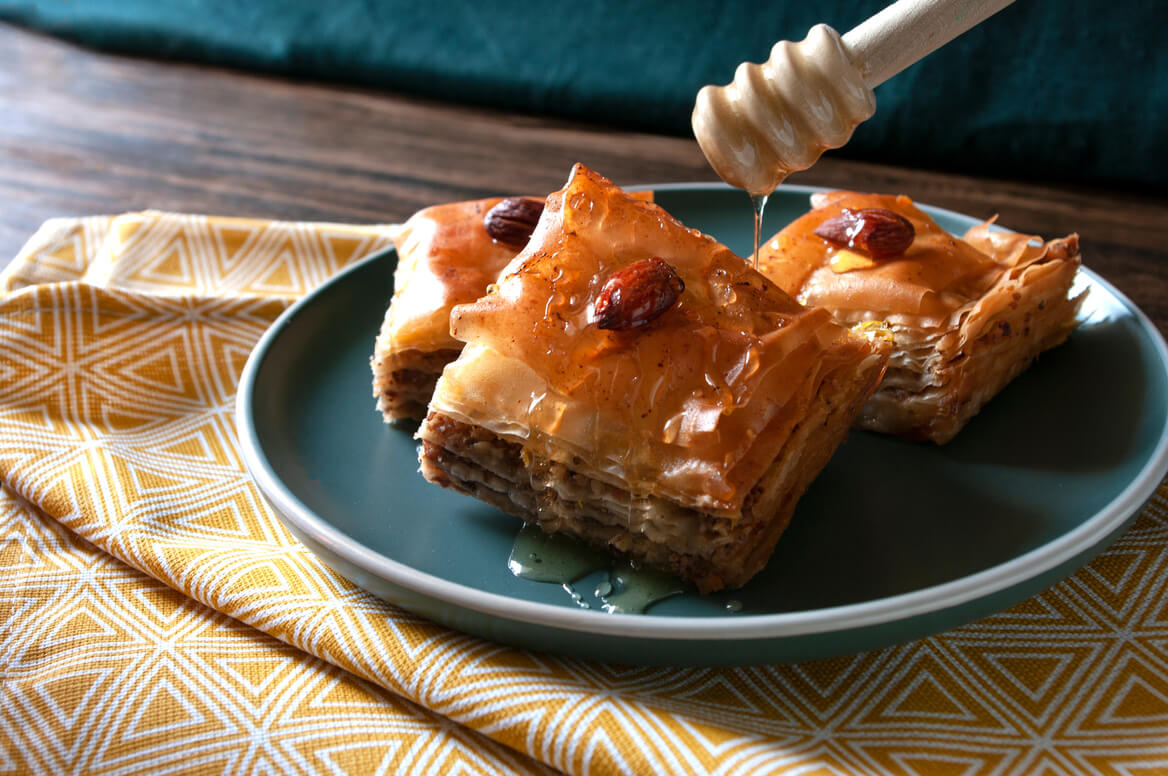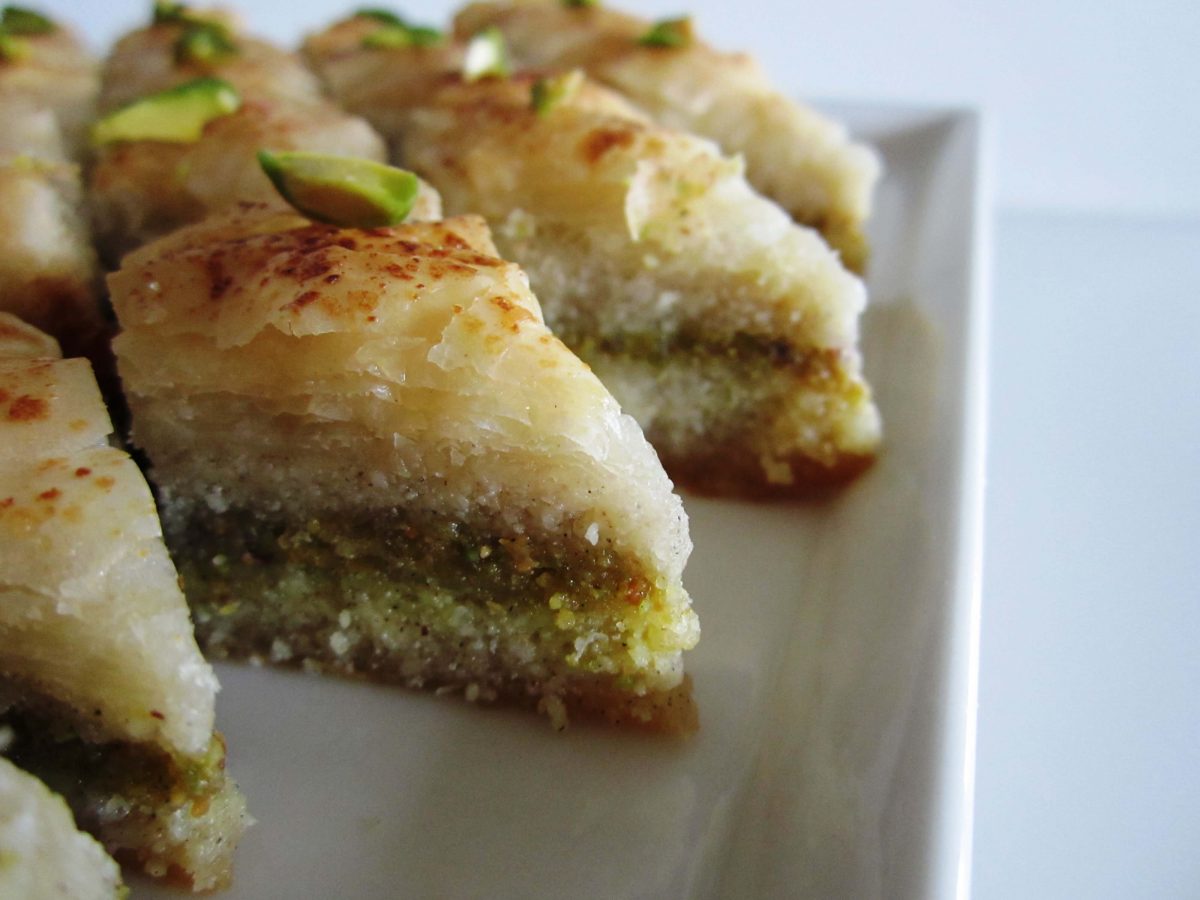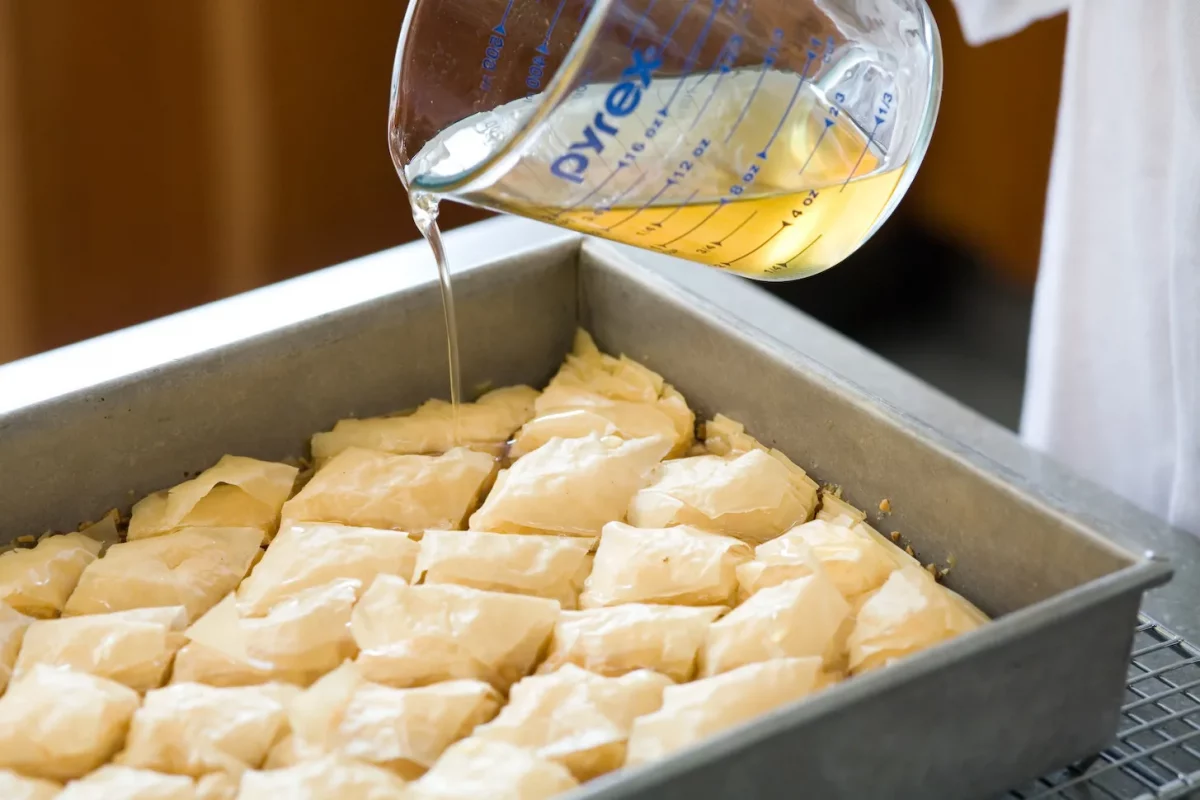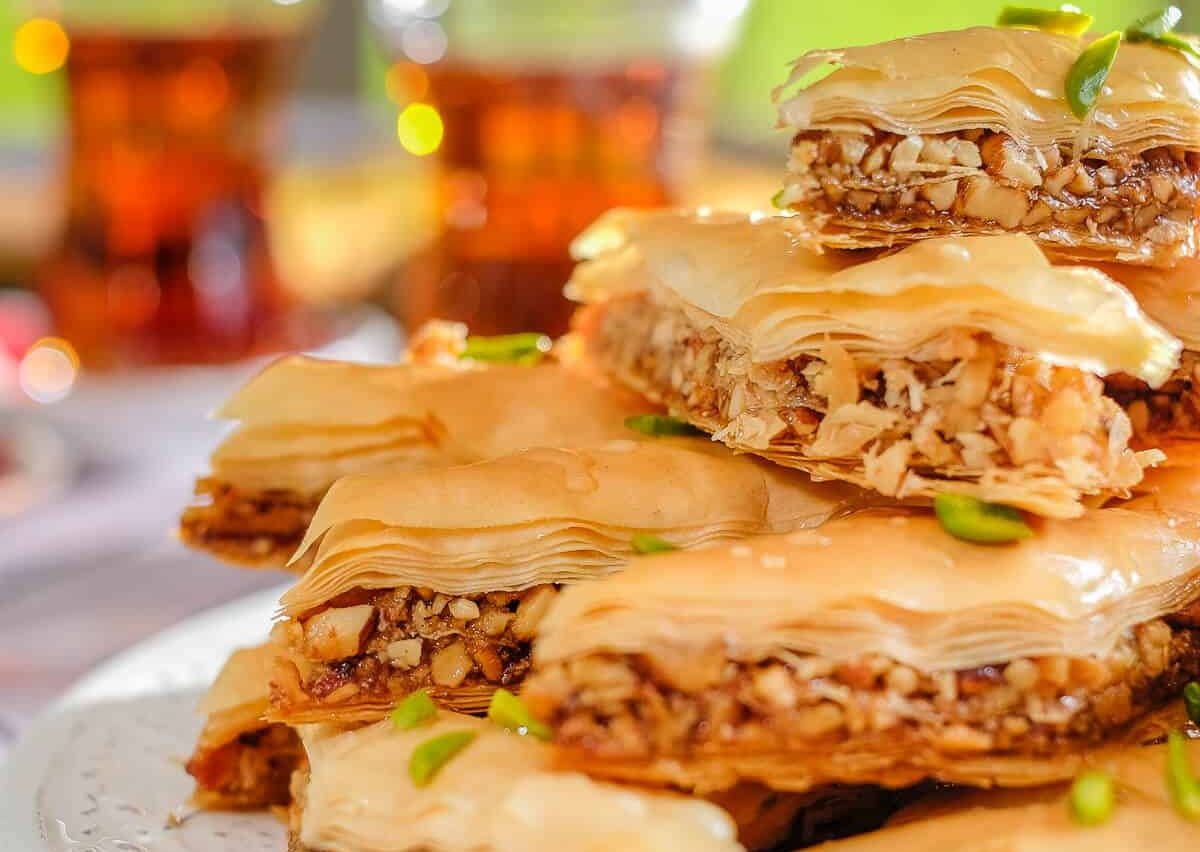A little bit of bliss, this Persian Style Baklava! Intoxicating smells of rose water, cardamom, and nutty brown butter are wrapped around flaky and crispy layers of pastry with roasted almonds steeped in luscious syrup. Not too sweet and quite unique. a thorough step-by-step guide.
Persian Style Baklava:

The Middle East, the Mediterranean, the Balkans, and the Caucasus are among the nations that once belonged to the Ottoman Empire. Baklava is a flaky pastry filled with chopped nuts and soaked in syrup.
The recipe I’m about to give you is in the Persian manner, which is really distinct from the standard variants.
I’ve been trying to create the ultimate baklava for years—layers of pastry that are perfectly crisp and kept together, and syrup that is consistently juicy. The outcome of years of research and testing is what you see here.
Making baklava is actually fairly simple. I finish it in around 30 minutes. The phyllo dough may provide the most obstacle, but with the advice I’ve provided below, that problem is readily solved.
Main Ingredients in Persian Style Baklava:
1. Phyllo Dough:
Buy a well-known brand from busy shops with good storage procedures, where the goods move quickly and aren’t left on the shelves for a long time.
In this manner, you may avoid having a stack of dough sheets that is dry or sticky. This has major significance.
Phyllo dough is often sold in sizes of 9 x 14 inches or 17 x 12 inches (24 to 28 sheets total) (40 sheets in two separate rolls). The 17 x 12 sheets may either be cut to suit the pan or fit nicely in a 17 x 12 baking sheet. Just add extra layers to a 9 x 13 pan if using the 9 x 14.
Make sure the phyllo dough is intended for baklava use since several companies produce a variety of varieties with different quantities.
2. Nuts:
I enjoy mixing walnuts (which have a gentle bite) with almonds or pistachios (firm bite). It’s crucial to chop them equally and finely. Use a food processor’s pulse feature or chop them by hand.
3. Butter:
You may buy pre-melted ghee or prepare your own clarified or brown butter. This baklava is elevated in flavour and has a greater smoke point when made using brown butter or ghee. Regular butter contains more than 15% water, which can lead to uneven baking. Additionally, the milk granules may create brown specks on the baklava.
4. Sweetener:
To prepare the syrup in this instance, I used some honey and sugar. For suggestions on healthier choices, see below.
5. Flavourings:
This baklava’s distinctive tastes include rose water, cardamom, and the nutty scent of brown butter.
6. Lemon juice:
This keeps the syrup juicy for weeks by preventing crystallisation. It also does so when some corn syrup is added.
Hands-on Tips For Phyllo Dough:

Dough for phyllo thaws overnight in the fridge. Before using, bring it to room temperature (I keep it for a couple of hours on the counter). Keep the container sealed until use.
All components should be ready before usage.
The dough should be carefully unrolled onto a clean, dry surface and covered with a moist cloth (not wet, wring it tight). The towel may be covered with wax paper or plastic wrap. Till required, keep dough covered.
To prevent edges from breaking, gently brush the edges before moving towards the middle. If a sheet tears, don’t worry. Use it as a patch in the middle layers. Save your finest linens for the top.
How To Make Persian Style Baklava Recipe:

- Phyllo dough should be thawed as directed on the packet. I defrost it overnight in the fridge and then leave it on the kitchen counter for two hours to reach room temperature.
- Advice: Thaw dough sheets a little longer at room temperature if they don’t split easily. I make sure they are separating well in advance so I can quickly and easily put my baklava together.
For Brown Butter:
- Sliced unsalted butter should be melted in a skillet or saucepan over medium heat. Stir constantly while simmering at low to medium heat.
- The milk solids will settle to the pan’s bottom when the foam subsides. Let milk solids toast until they are an amber brown colour and smell nutty. Keep it from burning.
- Pour the liquid quickly into a small saucepan that may be heated if necessary after straining it through a fine mesh strainer or cheesecloth.
Sugar Honey Syrup:
- In a medium saucepan, mix the lemon juice, sugar, and water. Over medium heat, bring to a boil while stirring to let the sugar dissolve.
- After five minutes of simmering at a lower heat, stir in the honey. Simmer for another 5 to 10 minutes.
- Add rose water after turning the heat off. The syrup is cooled to room temperature.
Advice: The syrup should be sufficiently sticky but not excessively thick to hold all of the phyllo layers together. The consistency should be between honey and maple syrup once it has cooled.
For Fillings:

- In a food processor, pulse walnuts until they are powdered. Before the nuts are evenly and finely ground, you might need to pulse the food processor 10 to 12 times. Continue with almonds.
- Mix the processed nuts with the sugar and cardamom powder.
The Assembling Stage:
- Throughout this procedure, keep the filtered brown butter melting at all times, gradually warming it up (not hot) if it thickens.
- Roll out the phyllo dough and wrap it in a moist cloth (not wet). I stacked the 28 sheets I had in my packet in layers of 10, 6, and 12, as seen below in the assembling of baklava. To fit the pan, cut the phyllo either before or after assembling.
- Butter should be applied to the baking sheet’s bottom and sides. The first phyllo sheet should be placed in the pan and butter should be brushed over it.
- Continue doing this until the bottom of the pan is filled with 10 greased phyllo sheets.
- Over the sheets of greased phyllo, evenly distribute half of the nut filling.
- Remove the towel, spread butter haphazardly on the top sheet, and brush it all over. Take a buttered phyllo sheet and arrange it buttered side down over the nut filling. Place the sheet in the oven with the greased side up.
- Brush butter one more over the top of that sheet. Put five more layers of buttered phyllo on top, making careful to equally brush the butter on each layer.
Advice: Before buttering the final sheet, gently press it down.
- Then equally distribute the remaining nut mixture over the phyllo dough. As we did in the previous step, take a greased phyllo sheet and arrange it buttered side down over the nut filling.
- Butter should once again be applied to the top of that sheet. Top with all of the remaining greased phyllo sheets (total of 12). The last layer should be liberally butter brushed, then drizzled with more melted butter.
Remember to lightly press each phyllo dough sheet down after stacking them before applying butter. This aids in compression, evenness, and elimination of any air pockets.
- Recap the layers of baklava in this order: 12 buttered phyllo sheets on top, 12 buttered phyllo sheets in the centre, 6 buttered phyllo sheets in the bottom, and 1/2 nut mixture.
- Cut the pastry into 2″ strips first using a very sharp knife, then cut across diagonally to create diamond shapes. For 25 minutes, bake in the centre of a 350°F preheated oven. Bake for an additional 25 to 30 minutes, or until golden brown, at 325°F.
- Take it out from the oven then add the syrup. For softened baklava, drizzle cooled syrup over heated baklava. Warm syrup over cooled baklava produces sharper baklava whereas hot syrup over cooled baklava produces softer but more flaky pastry. Baklava needs roughly two hours to completely cool.
- Pistachios can be sliced or finely chopped to decorate the baklava. Before serving, slice through the layers one more. When loosely covered with a tea towel or piece of cheesecloth, it may be kept at room temperature for two weeks.
Persian Style Baklava Recipe
A little bit of bliss, this Baklava! Intoxicating smells of rose water, cardamom, and nutty brown butter are wrapped around flaky and crispy layers of pastry with roasted almonds steeped in luscious syrup. Not too sweet and quite unique. a thorough step-by-step guide.

Ingredients
- 3 Ounces of thawed phyllo dough
- use as directed on the box.
- To produce brown butter, you will need roughly 212 sticks of 24 oz. unsalted butter (10 oz)
- Filling
- 1 pound of coarsely chopped walnuts, 2 to 212 cups
- 2 to 212 cups of coarsely chopped 1 pound of almonds or pistachios
- 5 cups of sugar
- Two teaspoons of ground cardamom, to taste
- Syrup
- Three cups sugar
- Water, 2 cups
- Lemon juice, 2 tablespoons
- Honey, 4 tablespoons
- Fourths of a cup
Directions
- Step 1 Phyllo dough should be thawed as directed on the packet. I defrost it overnight in the fridge and then leave it on the kitchen counter for two hours to reach room temperature.
- Step 2 Advice: Thaw dough sheets a little longer at room temperature if they don’t split easily. I make sure they are separating well in advance so I can quickly and easily put my baklava together.
- Step 3 For Brown Butter:
- Step 4 Sliced unsalted butter should be melted in a skillet or saucepan over medium heat. Stir constantly while simmering at low to medium heat.
- Step 5 The milk solids will settle to the pan’s bottom when the foam subsides. Let milk solids toast until they are an amber brown colour and smell nutty. Keep it from burning.
- Step 6 Pour the liquid quickly into a small saucepan that may be heated if necessary after straining it through a fine mesh strainer or cheesecloth.
- Step 7 Sugar Honey Syrup:
- Step 8 In a medium saucepan, mix the lemon juice, sugar, and water. Over medium heat, bring to a boil while stirring to let the sugar dissolve.
- Step 9 After five minutes of simmering at a lower heat, stir in the honey. Simmer for another 5 to 10 minutes.
- Step 10 Add rose water after turning the heat off. The syrup is cooled to room temperature.
- Step 11 Advice: The syrup should be sufficiently sticky but not excessively thick to hold all of the phyllo layers together. The consistency should be between honey and maple syrup once it has cooled.
- Step 12 For Fillings:
- Step 13 In a food processor, pulse walnuts until they are powdered. Before the nuts are evenly and finely ground, you might need to pulse the food processor 10 to 12 times. Continue with almonds.
- Step 14 Mix the processed nuts with the sugar and cardamom powder.
- Step 15 The Assembling Stage:
- Step 16 Throughout this procedure, keep the filtered brown butter melting at all times, gradually warming it up (not hot) if it thickens.
- Step 17 Roll out the phyllo dough and wrap it in a moist cloth (not wet). I stacked the 28 sheets I had in my packet in layers of 10, 6, and 12, as seen below in the assembling of baklava. To fit the pan, cut the phyllo either before or after assembling.
- Step 18 Butter should be applied to the baking sheet’s bottom and sides. The first phyllo sheet should be placed in the pan and butter should be brushed over it.
- Step 19 Continue doing this until the bottom of the pan is filled with 10 greased phyllo sheets.
- Step 20 Over the sheets of greased phyllo, evenly distribute half of the nut filling.
- Step 21 Remove the towel, spread butter haphazardly on the top sheet, and brush it all over. Take a buttered phyllo sheet and arrange it buttered side down over the nut filling. Place the sheet in the oven with the greased side up.
- Step 22 Brush butter one more over the top of that sheet. Put five more layers of buttered phyllo on top, making careful to equally brush the butter on each layer.
- Step 23 Advice: Before buttering the final sheet, gently press it down.
- Step 24 Then equally distribute the remaining nut mixture over the phyllo dough. As we did in the previous step, take a greased phyllo sheet and arrange it buttered side down over the nut filling.
- Step 25 Butter should once again be applied to the top of that sheet. Top with all of the remaining greased phyllo sheets (total of 12). The last layer should be liberally butter brushed, then drizzled with more melted butter.
- Step 26 Remember to lightly press each phyllo dough sheet down after stacking them before applying butter. This aids in compression, evenness, and elimination of any air pockets.
- Step 27 Recap the layers of baklava in this order: 12 buttered phyllo sheets on top, 12 buttered phyllo sheets in the centre, 6 buttered phyllo sheets in the bottom, and 1/2 nut mixture.
- Step 28 Cut the pastry into 2″ strips first using a very sharp knife, then cut across diagonally to create diamond shapes. For 25 minutes, bake in the centre of a 350°F preheated oven. Bake for an additional 25 to 30 minutes, or until golden brown, at 325°F.
- Step 29 Take it out from the oven then add the syrup. For softened baklava, drizzle cooled syrup over heated baklava. Warm syrup over cooled baklava produces sharper baklava whereas hot syrup over cooled baklava produces softer but more flaky pastry. Baklava needs roughly two hours to completely cool.
- Step 30 Pistachios can be sliced or finely chopped to decorate the baklava. Before serving, slice through the layers one more. When loosely covered with a tea towel or piece of cheesecloth, it may be kept at room temperature for two weeks.





